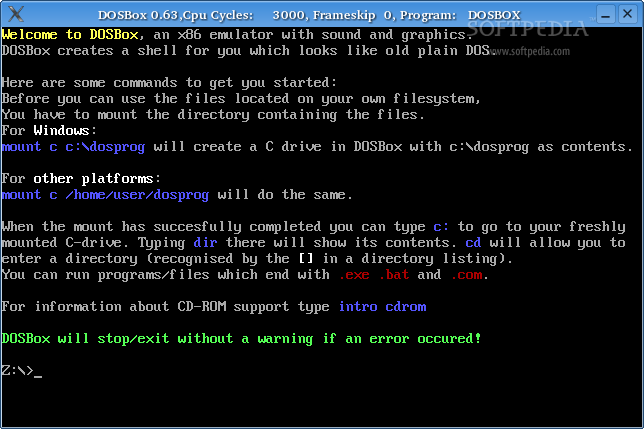
- #Mac os dos emulator mac os
- #Mac os dos emulator full
- #Mac os dos emulator software
- #Mac os dos emulator mac
While System 7 itself was 32-bit clean, many existing machines and thousands of applications were not, so it was some time before the process was completed. This change was known as being "32-bit clean".
#Mac os dos emulator full
This process involved making all of the routines in OS code use the full 32 bits of a pointer as an address-prior systems used the upper bits as flags. System 7 paved the way for a full 32-bit address space, from the previous 24-bit address space.
#Mac os dos emulator mac
Although technically not a new feature for System 7 (as these features were available for System 6.0.7), Sound Manager 2.0 was the first widespread implementation of this technology to make it to most Mac users. The new APIs featured significantly improved hardware abstraction, as well as higher-quality playback.
#Mac os dos emulator mac os
In March 1988, shortly before the release of System 6, technical middle managers at Apple held an offsite meeting to plan the future course of Mac OS development. By the late 1980s, the list of new upgrades and suggested changes to the existing model was considerable. Numerous examples of this sort of problem could be found throughout the system.įinally, the widespread adoption of hard drives and local area networks led to any number of new features being requested from users and developers. Yet, as MultiFinder was still optional, such a step had not been taken. If the system were able to support multiple tasks, this one-off solution would no longer be needed - desk accessories could simply be small programs, placed anywhere. For instance, to support a limited form of multitasking, the original Mac OS supported small co-resident programs known as desk accessories which had to be installed into the system using special tools. While additions had been relatively limited, so had fixes to some of the underlying oddities of the system architecture.

Running MultiFinder normally required a larger amount of RAM and a hard drive, but these became more common by the late 1980s. Most notable among these was the single-tasking model, the replacement of which had first been examined in 1986's "Switcher" and then replaced outright with MultiFinder in System 5. However, many of the assumptions of this model were no longer appropriate. That is, the machine was geared towards a single user and task running on a floppy disk based machine of extremely limited RAM.

These limited changes meant that the original Macintosh system remained largely as it was when initially introduced. This initially shipped in three volumes, adding another to describe the changes introduced with the Mac Plus, and another for the Mac II and Mac SE. Some perspective on the scope of the changes can be seen by examining the official system documentation, Inside Macintosh.
#Mac os dos emulator software
The development of the Macintosh system software up to System 6 followed a fairly smooth progression with the addition of new features and relatively small changes and upgrades over time.


 0 kommentar(er)
0 kommentar(er)
